John Tonory, O.S.A. was Bishop of Ossory [1] from 1566 [2] until his death on 3 August 1576.
Tonory was nominated in December 1553 by Queen Mary I and consecrated on January 1554, but after the accession of Queen Elizabeth I he was replaced. [3]
John Tonory, O.S.A. was Bishop of Ossory [1] from 1566 [2] until his death on 3 August 1576.
Tonory was nominated in December 1553 by Queen Mary I and consecrated on January 1554, but after the accession of Queen Elizabeth I he was replaced. [3]
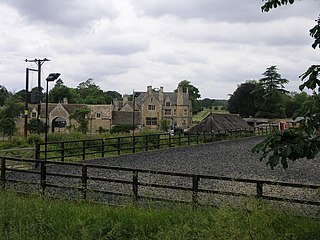
John FitzPatrick, 1st Earl of Upper Ossory was an Anglo-Irish nobleman who lived in County Cork, Ireland.
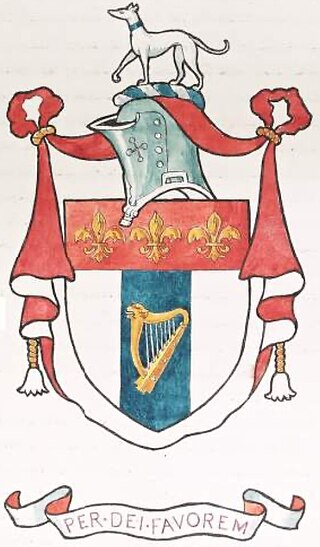
Brophy is an Irish surname of ancient origin, which is derived from the Irish "Uí Bhróithe" or "Ó Bróithe" septs that were located mostly around Ballybrophy, Laois, and in counties Carlow and Kilkenny. The family has been prominent in the history of Ireland for nearly 1000 years and has included petty kings (Rí), clerics, soldiers, and writers. The family was first mentioned in the late 11th century, but as a member of the Dál Birn dynasty, its semi-legendary genealogy stretches back to AD 200 according to the Bodleian Library, MS Rawlinson B 502. As such, it remains one of Ireland's oldest extant pre-Norman Conquest noble families, being related to the kings of Osraige and the Fitzpatrick dynasty as represented by the Earl of Upper Ossory, Baron Upper Ossory, and Baron Castletown.
During the Tudor conquest of Ireland (c.1540–1603), "surrender and regrant" was the legal mechanism by which Irish clans were to be converted from a power structure rooted in clan and kin loyalties, to a late-feudal system under the English legal system. The policy was an attempt to incorporate the clan chiefs into the English-controlled Kingdom of Ireland, and to guarantee their property under English common law, as distinct from the traditional Irish Brehon law system. This strategy was the primary non-violent method for Crown officials in the Dublin Castle administration to subjugate Irish clan leaders during the conquest. It was an unanticipated consequence to be required to pay fealty in currency instead of trade labor or commodities. The process of "surrender and regrant" thus created new, unfamiliar debt structures among the Irish, and these debts had social and political consequences.
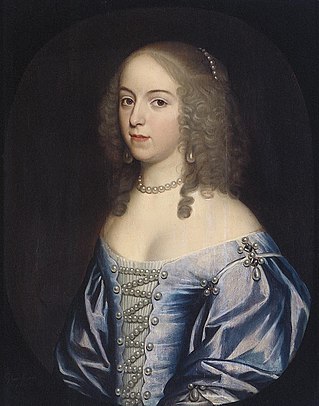
Emilia Butler, Countess of Ossory, born Æmilia van Nassau-Beverweerd, was an Anglo-Dutch courtier.
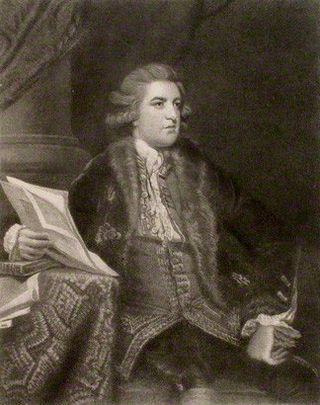
Earl of Upper Ossory was a title in the Peerage of Ireland. It was created on 5 October 1751 for John FitzPatrick, 2nd Baron Gowran, who later represented Bedfordshire in the House of Commons. He was the son of Richard FitzPatrick, who had been created Baron Gowran on 27 April 1715, also in the Peerage of Ireland. Lord Gowran had represented Harristown and Queen's County in the Irish House of Commons before his elevation to the peerage. The first Earl's son, the second Earl, also sat as Member of Parliament for Bedfordshire and was Lord Lieutenant of Bedfordshire. In 1794, he was created Baron Upper Ossory, of Ampthill in the County of Bedford, in the Peerage of Great Britain. However, all three titles became extinct on his death in 1818.

Baron Castletown, of Upper Ossory in the Queen's County, was a title in the Peerage of the United Kingdom. It was created on 10 December 1869 for John FitzPatrick, the former Liberal Member of Parliament for Queen's County. He was the illegitimate son of John FitzPatrick, 2nd Earl of Upper Ossory.

The Diocese of Ossory is a Latin Church diocese of the Catholic Church in eastern Ireland. It is one of three suffragan dioceses in the ecclesiastical province of the Metropolitan Archbishop of Dublin. Currently, it is led by Niall Coll who was appointed on 28 October 2022 and will be ordained bishop on 22 January 2023.

The Bishop of Ossory is an episcopal title which takes its name after the ancient of Kingdom of Ossory in the Province of Leinster, Ireland. In the Roman Catholic Church it remains a separate title, but in the Church of Ireland it has been united with other bishoprics.
Events from the year 1385 in Ireland.
Events from the year 1553 in Ireland.
The Bishop of Ossory, Ferns and Leighlin was the Ordinary of the Church of Ireland diocese of Ossory, Ferns and Leighlin in the Ecclesiastical Province of Dublin. The diocese consisted of counties Kilkenny, Carlow, Laois and Wexford in Ireland.
The Bishop of Cashel and Ossory is the Ordinary of the United Diocese of Cashel, Waterford and Lismore with Ossory, Ferns and Leighlin in the Church of Ireland. The diocese is in the ecclesiastical province of Dublin.
Mervyn Archdall was an Irish antiquary and clergyman of the Church of Ireland.

The United Dioceses of Cashel and Ossory is a diocese of the Church of Ireland in the south-eastern part of Ireland that was formed from a merger of older dioceses in 1977. The diocese is in the ecclesiastical province of Dublin.
John Hartstonge or Hartstongue was an English-born prelate of the Church of Ireland who became Bishop of Ossory and then Bishop of Derry.

Upper Ossory was an administrative barony in the south and west of Queen's County in Ireland. In late Gaelic Ireland it was the túath of the Mac Giolla Phádraig (Fitzpatrick) family and a surviving remnant of the once larger kingdom of Ossory. The northernmost part of the Diocese of Ossory and medieval County Kilkenny, it was transferred to the newly created Queen's County, now known as County Laois, in 1600. In the 1840s its three component cantreds, Clarmallagh, Clandonagh, and Upperwoods, were promoted to barony status, thereby superseding Upper Ossory.
The Queen's County Ossory, by-election, 1886 was a parliamentary by-election held for the United Kingdom House of Commons constituency of Queen's County Ossory on 12 February 1886. Arthur O'Connor of the Irish Parliamentary Party, member for the former Queen's County constituency, having been elected both in this seat and in East Donegal, chose to sit for the latter. The Queen's County Ossory seat thus became vacant, requiring a by-election. Only one candidate, Stephen O'Mara of the Irish Parliamentary Party, was nominated, and was elected unopposed. He held the seat until the general election later that year, which he did not contest.
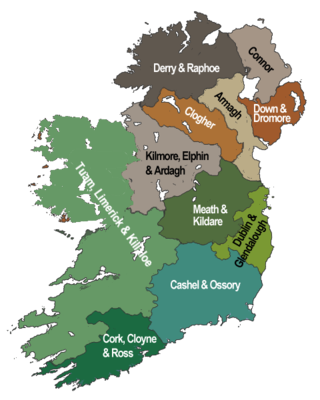
The Archdeacon of Ossory was a senior ecclesiastical officer within the Diocese of Ossory until 1835 and then within the Bishop of Ossory, Ferns and Leighlin until 1977 when it was further enlarged to become the Diocese of Cashel and Ossory. As such he was responsible for the disciplinary supervision of the clergy within the Cloyne Diocese.
Jonas Wheeler (1543–1640) was Bishop of Ossory from 1613 until his death in 1640.

Clarmallagh is a barony in County Laois, Ireland.